The educational tourism market is projected to be valued at USD 754.6 billion in 2025 and is anticipated to grow to USD 3,732.5 billion by 2035, registering a compound annual growth rate (CAGR) of 17.2% over the forecast period.
Educational tourism, which involves travel for the purpose of learning experiences, is experiencing rapid growth as more students, professionals, and lifelong learners seek international learning opportunities. This market encompasses a wide range of activities, including study tours, cultural exchanges, language immersion programs, and vocational training.
A significant driver of this market’s growth is the increasing globalization of education and the rising demand for cross-cultural learning experiences. With growing access to international educational institutions, students are more eager to gain knowledge and experience abroad.
The popularity of short-term educational programs and language courses in countries known for their educational prowess is also contributing to market expansion. Furthermore, the trend of combining travel with educational experiences is gaining momentum, as people seek meaningful and enriching travel that adds value to their personal and professional development.
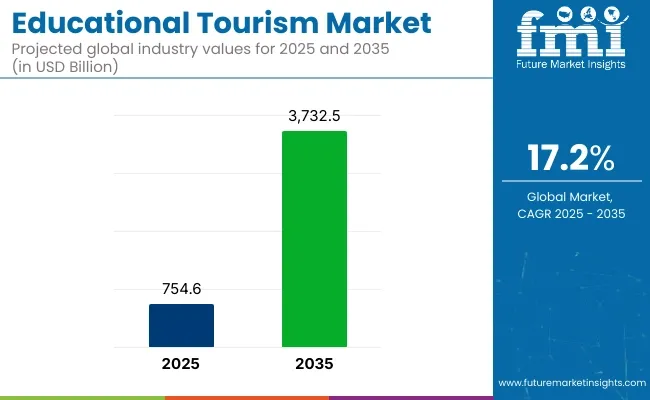
| Attribute | Value |
|---|---|
| Market Size in 2025 | USD 754.6 billion |
| Market Size in 2035 | USD 3,732.5 billion |
| CAGR (2025 to 2035) | 17.2% |
Recent developments in the educational tourism market include the integration of virtual learning platforms, making it easier for students to engage in global programs without leaving their home country.
In September 2024, EF Educational Tours introduced EF Adventures, a new travel program offering over 20 guided tours across 16 countries. Designed for travelers seeking active, culturally immersive experiences, the program includes hiking, biking, and multi-adventure itineraries. Departures began in October 2024, catering to the growing demand for experiential learning and wellness-focused travel.
As the educational tourism market grows, the increasing interest in experiential learning and international collaboration will continue to drive its expansion, with both short-term and long-term educational travel experiences gaining popularity globally.
The global educational tourism market is expected to grow significantly through 2035. In 2025, the 19-25 age group is projected to hold 73% of the age segment, while postgraduate education is expected to capture 36% of the education type segment. Key players include EF Education First, Kaplan International, and Study Group.
The 19-25 age segment is projected to account for 73% of the market share in 2025. This group primarily comprises undergraduate and early postgraduate students seeking global academic and cultural exposure. Factors such as increased scholarship opportunities, affordable travel, and digital connectivity facilitate mobility.
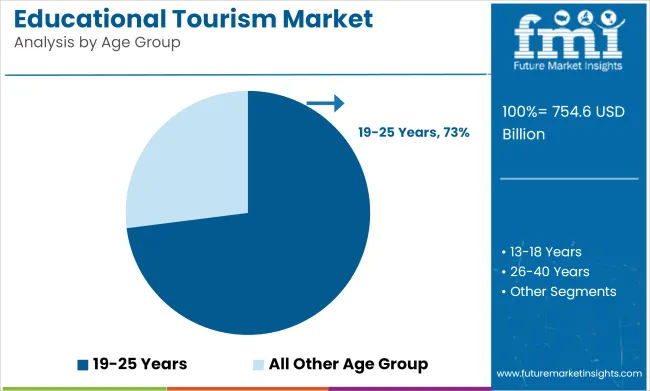
Companies like EF Education First provide language programs and study tours tailored to this demographic. The segment benefits from rising interest in gap years, internships abroad, and cross-cultural skill development. As universities internationalize and collaborate globally, demand from this age group for immersive educational experiences continues to accelerate.
The postgraduate education segment is expected to hold 36% of the education type market share in 2025. Increasing emphasis on specialized skills, research opportunities, and career advancement is driving growth. Institutions and providers offer tailored programs in business, engineering, and healthcare that attract international students seeking advanced credentials.
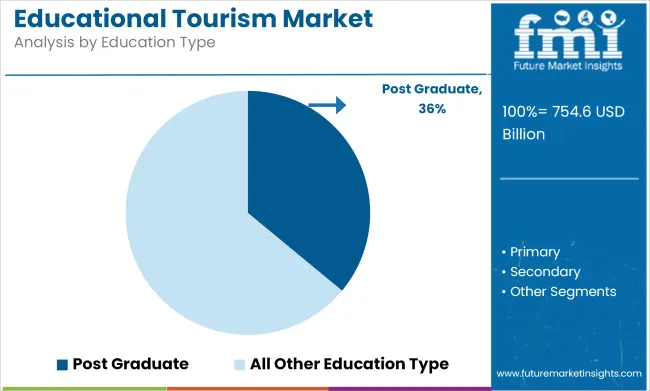
Kaplan International and Study Group focus on pathway programs and test preparation for postgraduate entry. Rising demand from emerging economies and evolving professional requirements fuel this segment. As global job markets value higher education qualifications, postgraduate educational tourism remains a key growth pillar within the broader market.
School trips are usually prearranged by the teachers or the students’ parents through private agencies or through scholarships provided by Ministries of Education. They are usually of short or medium stays since the students are of low age.
The main aim is to develop cultural knowledge and other languages. Moreover, the modality to learn foreign languages among young children is spurring, as they have more sharp and flexible minds than adults and therefore a greater ability to learn another language.
Thus, rising demand for national and international school trips is expected to supplement the market growth throughout the forecast period.
Private universities offer the opportunities to learn and explore alongside world-class faculty, for a lifetime of personal achievement. Further, many private universities have started the trend of foreign internships or international tours for a period of 2 to 3 months, which is creating a lot of traction among millennials.
As a result, they are willing to pay high prices for the courses in order to visit abroad. In addition, governments around the world, particularly those in developing countries, face significant educational challenges. As a result, students are more attracted towards private universities and colleges for further studies.
In Feb 2021, India gave the green-light to dual and joint degrees which are awarded by Indian universities with international partners as part of its internationalization plan being pushed through forcefully since its inclusion last year in the National Education Policy (NEP).
According to Future Market Insights, the USA. is expected to account for over 3/4th of market share in educational tourism market. The market is acquiring popularity with regards to education, as it provides and strives to maintain the best educational facilities, encourages educational tours and spends on quality learning and research.
Presence of ivy-league collages and informative & profitable courses offered in the country for the students is propelling the market growth. Diverse international study programs and student exchange programs offered in the universities are attracting the international student bodies to the USA. ivy and community colleges.
Brazil is identified as the most attractive region for educational tourism and international studies among youth. The most significant economic feature of activities is that they contribute to three high-priority goals: the foreign exchange earnings, generation of income, and employment.
One of the main advantages of educational tourism is the ability to earn money through foreign exchange. Educational tourism expenditure generates income for the host economy. The money that the country makes from tourism is then reinvested in the economy.
Some countries like Brazil utilize the money on increasing their tourism industry further, while some countries in Latin America region spend the money on public services such as healthcare and education. In this respect, the educational tourism sector can play an important role as a driving force of economic development.
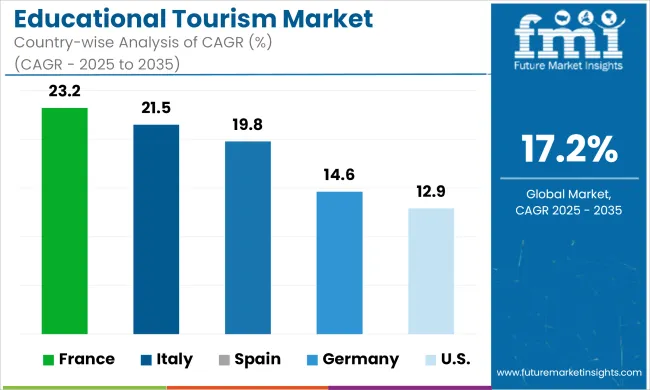
One of the benefits of educational tourism is the opportunity to have a new experience and witness different cultures especially in South-Asian countries such as India. Traveling outside one’s home region and comfort zone enhances the knowledge about different cultures in the world.
Educational tourists visit the area in order to learn more about a culture, or visit cultural and tourist attractions point, such as museums and live shows during the journey, which further helps to contribute to the economic growth of the area. Attractions must be staffed, bringing with it employment prospects, and tertiary businesses can also benefit, such as restaurants, taxi firms and hotels.
Furthermore, for those seeking in-depth cultural experiences, options such as homestays can have positive economic benefits for the members of the community which hosts the tourists. As a result, educational tourism activity helps oneself to understand the history and culture beyond their geographical location, which is further driving the education tourism industry.
Besides this, favorable government initiatives and offers on attractive Master’s degree and secondary education are expected to woo a lot of foreign exchange students, propelling the growth of educational tourism market.
The players are primarily engaged to establish a new standard for education and international development organizations and social enterprises. Further, several players run National Scholarship Programs (NSP) worldwide to enable and fund local nationals to participate in their programs and receive all relevant training.
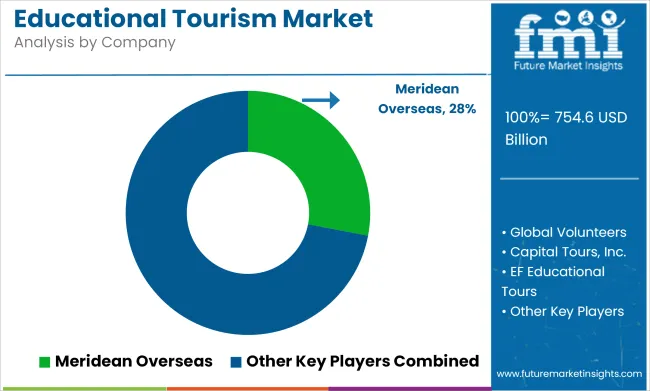
Moreover, the players are adopting a virtual and online approach to connect with potential people/students. For instance, GVI Company provides virtual internship program and online classes. This approach helps the company to attract more people.
| Report Attributes | Details |
|---|---|
| Current Total Market Size (2025) | USD 754.6 billion |
| Projected Market Size (2035) | USD 3,732.5 billion |
| CAGR (2025 to 2035) | 17.2% |
| Base Year for Estimation | 2024 |
| Historical Period | 2020 to 2024 |
| Projections Period | 2025 to 2035 |
| Quantitative Units | USD billion for dollar sales |
| Age Group Distribution (Segment 1) | Less Than 12 Years, 13-18 Years, 19-25 Years, 26-40 Years, 41-55 Years |
| Education Type Distribution (Segment 2) | Primary, Secondary, College, Post Graduate |
| Type of Occupation Distribution (Segment 3) | Students, Scholars, Teachers, Government Officials, Corporation Managers, Enterprise Owners, Workers, Others |
| Course Type Distribution (Segment 4) | Master Degree, Secondary Education, Primary Education |
| Regions Covered | North America, Latin America, Europe, East Asia, South Asia, Oceania, Middle East and Africa (MEA) |
| Countries Covered | United States, Canada, Mexico, Brazil, Argentina, Germany, France, United Kingdom, Italy, Spain, Netherlands, China, India, Japan, South Korea, ANZ, GCC Countries, South Africa |
| Key Players influencing the Educational Tourism Market | Meridean Overseas, GVI Company, Global Volunteers, Capital Tours, Inc., EF Educational Tours, Road Scholar, AAI Edutourz, ACIS Educational Tours, GoIreland, Qadri International Education Consultancy, Intelligent Partners, Futures Abroad, ProEd DMCC, Education Resources Network (ERN), Education Zone, Fact, IQ Education Consultants, M.K.H Consultancy Services, Stratix Consultants |
| Additional Attributes | dollar sales, CAGR trends, age group preferences, education type segmentation, occupation distribution, course type demand, competitor dollar sales & market share, regional growth patterns |
In 2025, the educational tourism market is expected to reach a valuation of over USD 754.6 billion.
The educational tourism market grew at an impressive CAGR of 12.9% from 2020 to 2024.
Meridean Overseas, GVI Company, Global Volunteers, Capital Tours, Inc., EF Educational Tours, Road Scholar, AAI Edutourz, ACIS Educational Tours, GoIreland, Qadri International Education Consultancy, and Intelligent Partners are some of the leading market players, cumulatively accounting for a 15%-20% value share.
The U.S., the U.K., France, Canada, Hong Kong, New Zealand, Russia, Japan, Germany, China, Australia, and India, are major countries reflecting consistently high demand for educational tourism.
The educational tourism market grew by USD 56.6 Billion between 2020 and 2021.
Demand for new courses, increasing government initiatives to boost country’s tourism industry, and millennials growing interest to experience the culture and understand history of different places are some of the key factors that will fuel the growth.
As per Future Market Insights, North America will account for over 31% of global market share during the forecast period.
Europe will contribute nearly 27% of the global market share in educational tourism market over the next decade.
Increasing focus on promoting educational tourism as a development strategy by various countries around the world will continue positively affecting sales. Besides this, government policies aimed at boosting a country’s image as destination for educational tourism will create opportunities for growth.






Full Research Suite comprises of:
Market outlook & trends analysis
Interviews & case studies
Strategic recommendations
Vendor profiles & capabilities analysis
5-year forecasts
8 regions and 60+ country-level data splits
Market segment data splits
12 months of continuous data updates
DELIVERED AS:
PDF EXCEL ONLINE
UK Educational Tourism Market Insights – Size, Demand & Innovations 2025-2035
USA Educational Tourism Market Report – Size, Growth & Industry Trends 2025-2035
China Educational Tourism Market Insights – Trends, Growth & Forecast 2025-2035
Europe Educational Tourism Market Trends - Growth & Forecast 2025 to 2035
France Educational Tourism Market Analysis – Trends, Growth & Forecast 2025-2035
Australia Educational Tourism Market Report – Growth, Innovations & Forecast 2025-2035
United States and Canada Educational Tourism Market Growth, Trends and Forecast from 2025 to 2035
Educational Toys Market Analysis and Overview by Category, End-use Sector, and Area through 2035
Educational Robots Market Analysis by Type, Application, and Region Through 2035
Tourism Independent Contractor Model Market Size and Share Forecast Outlook 2025 to 2035
Tourism Industry Analysis in Japan - Size, Share, & Forecast Outlook 2025 to 2035
Tourism Market Trends – Growth & Forecast 2025 to 2035
Tourism Industry Big Data Analytics Market Analysis by Application, by End, by Region – Forecast for 2025 to 2035
Assessing Tourism Industry Loyalty Program Market Share & Industry Trends
Tourism Industry Loyalty Programs Sector Analysis by Program Type by Traveler Profile by Region - Forecast for 2025 to 2035
Market Share Insights of Tourism Security Service Providers
Tourism Security Market Analysis by Service Type, by End User, and by Region – Forecast for 2025 to 2035
Competitive Overview of Geotourism Market Share
Geotourism Market Insights - Growth & Trends 2025 to 2035
Global Ecotourism Market Insights – Growth & Demand 2025–2035

Thank you!
You will receive an email from our Business Development Manager. Please be sure to check your SPAM/JUNK folder too.
Chat With
MaRIA